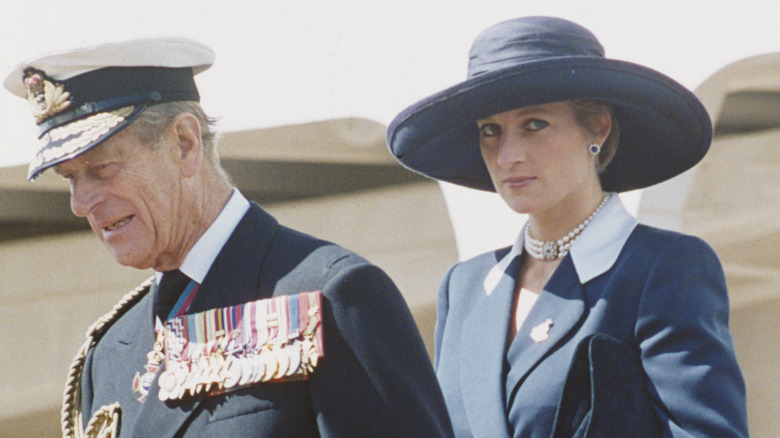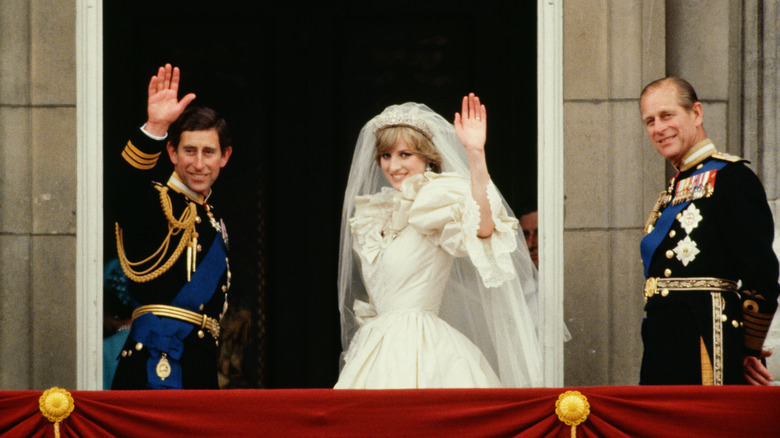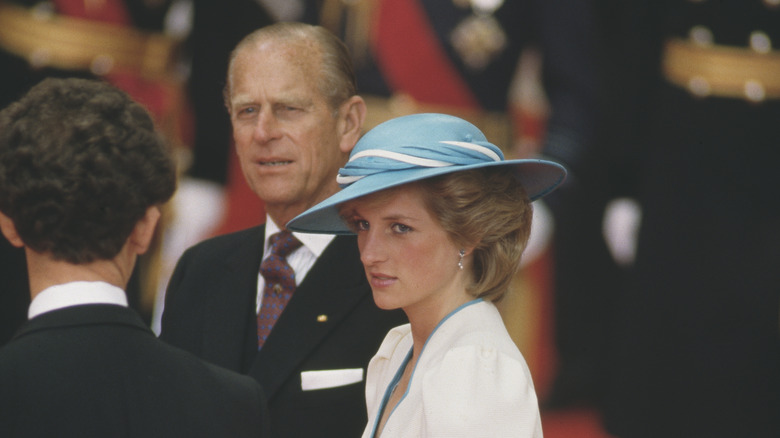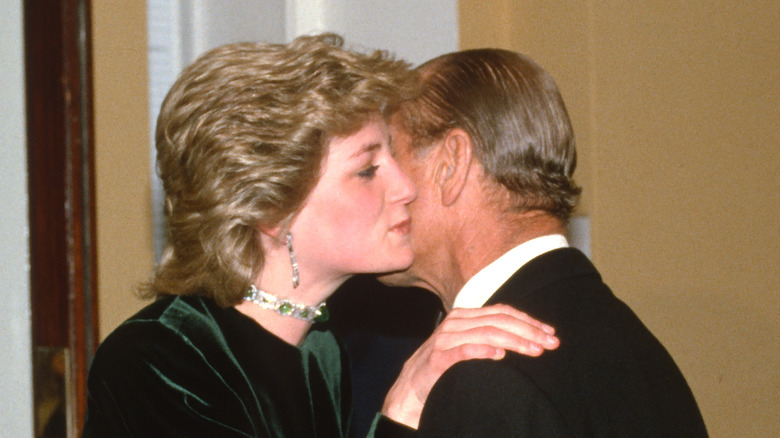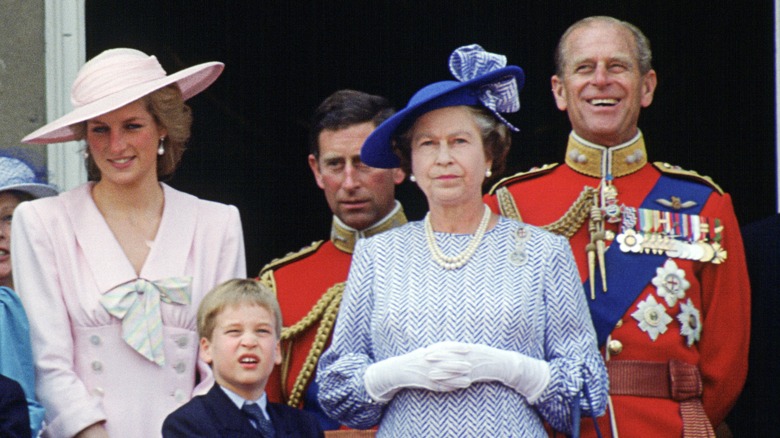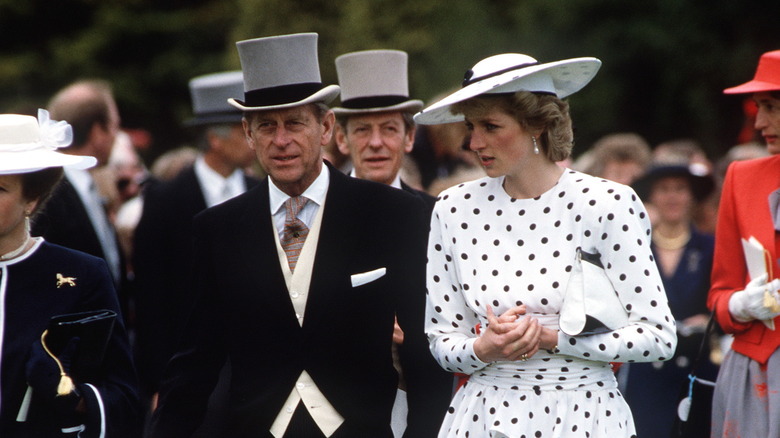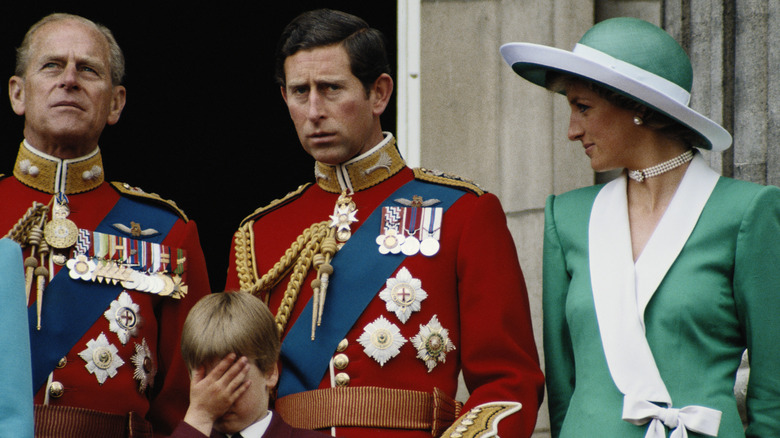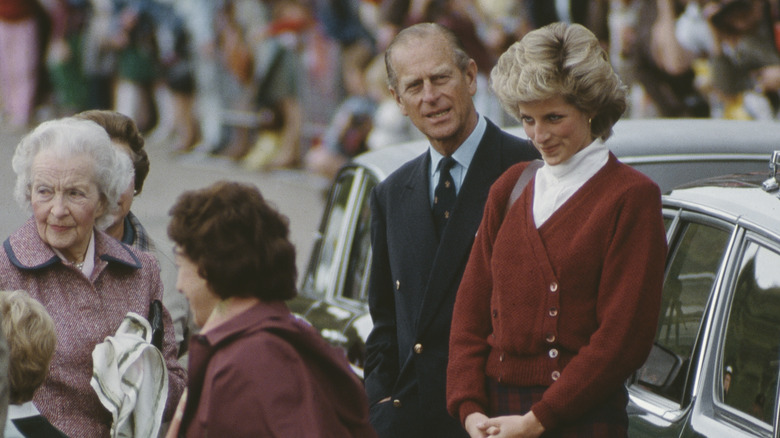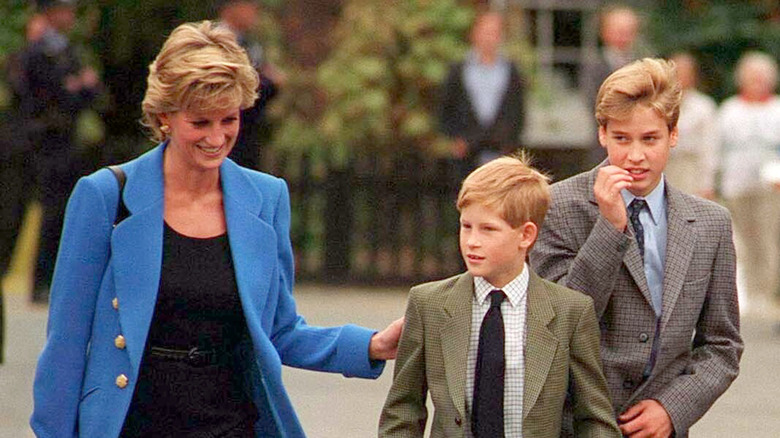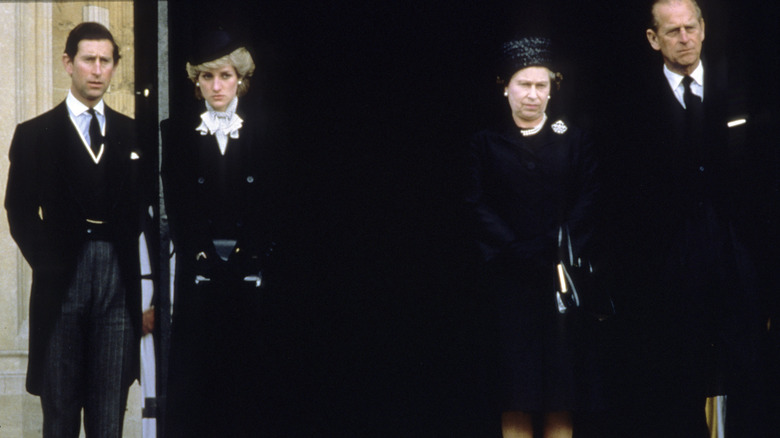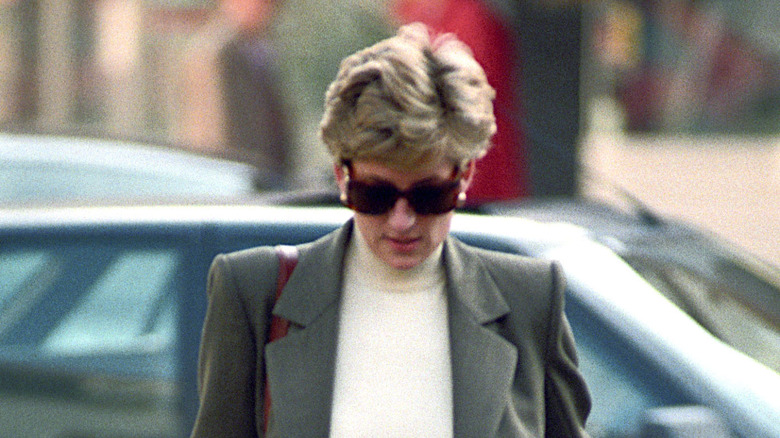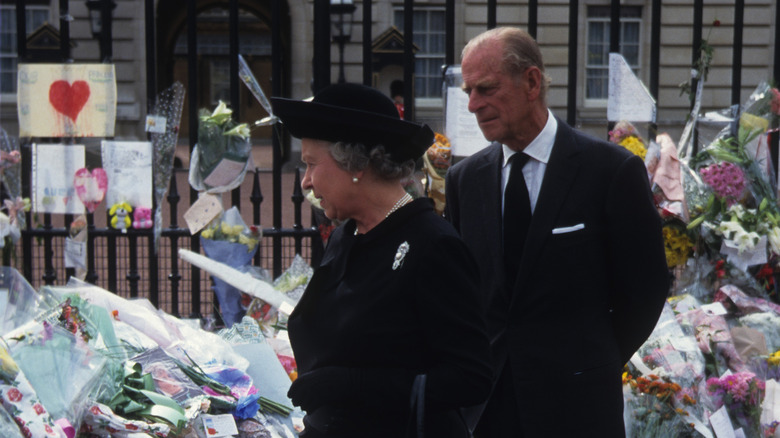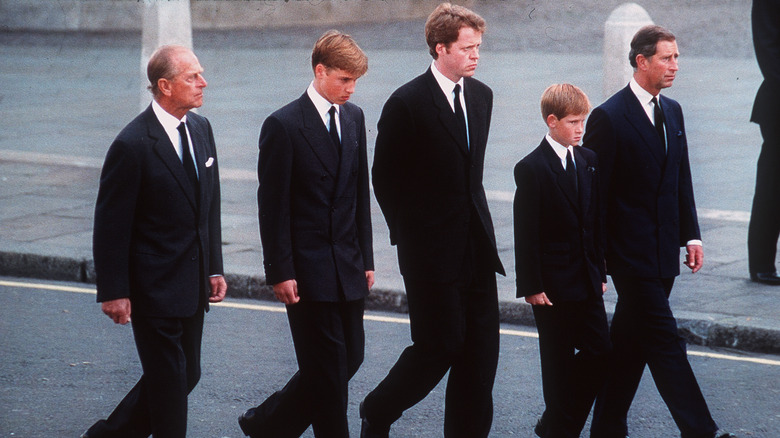What Prince Philip And Princess Diana's Relationship Was Really Like
Of the royals who have come and gone, few have rivaled Prince Philip's dedication to the crown. Having married into the royal family shortly before his wife became Queen Elizabeth II, Philip became the longest-serving consort in British history, serving as a dependable partner to the queen throughout her seven decades on the throne.
Philip — throughout his years in the public eye — became known for his no-nonsense demeanor, his abrasive approach, and his rather emotionless approach to the job. In many ways, his daughter, Princess Anne, has embodied his characteristics, presenting a dignified front to the public that is always ready to approach the job at hand. In stark contrast to this was Diana Spencer, the young bride who married King Charles III and captured the hearts of the British public while doing so. An openly emotive royal who often let her expressions do the talking, Diana could not have been more different than her father-in-law, prompting some to assume that the two did not see eye-to-eye during their mutual time as royals.
Of course, Diana and Charles separated in 1992 and would eventually get divorced, placing what many would assume to be even more strain on her relationship with the family. And while things between Diana and Philip did eventually devolve over time, the two shared an uncanny friendship that guided much of their mutual time serving the monarchy. Here, we're taking a closer look at what Prince Philip and Princess Diana's relationship was really like.
Philip was welcoming to Diana for this specific reason
Though Prince Philip appeared to embody Great Britain in all its glory, he actually was born in Greece to the country's Prince Andrew and had to renounce his Grecian royal titles in order to marry Queen Elizabeth II. As he had come to the royal family as the definition of an outsider, he was said to have a particular soft spot for those who also married into the family, as he knew how daunting the life of a consort appeared from the outside looking in.
Speaking to his profound perspective was host and journalist Lizzie Robinson, who shed light on his role during an episode of the ITV podcast, "Royal Rota." Discussing Philip's point of view and how it allowed him and Diana Spencer to share a friendship built on common ground, Robinson noted that Philip kept a keen eye out for Diana in the early days of her royal life and made it clear that he was in her corner.
"He was such a central part of the family," Robinson said during an April 2021 episode of the podcast, noting that he recognized Diana's place as an outsider, much like his own. "Often people talk about how the queen was head of the firm and he was head of the family. And he's been there for all of them for so long."
Did Diana and Philip really go hunting together in their early friendship?
Any fan of Netflix's "The Crown" knows that a fictional Diana Spencer and Prince Philip went hunting together on the grounds of Balmoral in the early days of their introduction, seemingly bonding over the intentional movements of the stag they were pursuing. The episode, entitled "The Balmoral Test," presented Diana as a quiet yet ambitious young woman who bonded with Philip over their tactile manner — but did such an interaction between them actually happen? According to royal butler Grant Harrold, any stay at Balmoral likely included some sort of hunt, and while the actual scene depicted in "The Crown" was fictional, Harrold maintains that it was based on known practices of the royals.
"If [the queen] invites you to Balmoral, then you are being invited to spend time with the royal family in a personal setting," Harrold explained to the Daily Record. "You are going to be out on the hills with the queen or other members of the royal family, perhaps fishing, hunting or doing other country pursuits."
In fact, Diana was once criticized in her early years of being a royal for hunting, facing allegations that she significantly wounded a deer while out with her soon-to-be husband. And while Philip and Diana's fictional selves may have bonded over the excursion, it's likely that such interactions really did take place.
Diana and Philip joined forces whenever appearing together in public
Prince Philip and Diana Spencer certainly seemed as though they represented two sides of the royal spectrum — one was incredibly stoic, keeping his feelings tucked firmly away at all times, and the other was known for being vocal about her experiences and true feelings about royal life. Such differences would let many assume that Philip and Diana shared an adversarial relationship, but they actually supported one another behind doors and in public. In her book, "Prince Philip Revealed" (via People), royal author Ingrid Seward detailed the specific ways Diana and Philip bolstered each other, noting that Philip took Diana under his wing even after she got married.
"When (Diana) found the restrictions of royal life difficult, it was Philip who helped her," Seward noted. "Once she was married, she never sat next to her husband; she was always sat next to Philip at the endless black-tie dinners, and he took care of her."
Paying close attention to Diana's experiences with the royals in Scotland specifically, Seward revealed, "Diana found the Balmoral dinners a massive strain and the atmosphere stifling. When the piper came around the table after dinner with his kilt swirling and his pipes whining, she couldn't wait to leave the room." Yet it was Philip who helped make the experience bearable for the young Princess of Wales.
This unique expert weighed in on the kinship shared between the two royal outsiders
When bringing a historical figure to life in a fictional world, a certain amount of insight is needed. "The Crown" has continued to present fictionalized accounts of life within the royal family from Queen Elizabeth II's early reign to the 1990s, and one thorough actor gave his two cents about Prince Philip and Diana Spencer's friendship amid the release of Season 4. Tobias Menzies — who brought Philip to life on the screen — told People just what he thought about the two royal spouses forging a unique bond.
"There are some similarities in that ... it's another outsider, a position that he obviously has been in. Maybe he has some kind of appreciation for the challenges that she's going through," Menzies said. "I think on a very basic level, he just thinks it's a good fit. In a slightly old-fashioned way, I think he also just liked her femininity, her beauty. He was sort of very seduced by her as well."
Menzies continued, saying that Philip and Diana were also bonded by their mutual dedication to King Charles III, both working to ensure his future as monarch. "Someone who is strong beside him or someone who can make that team work [is vital]," Menzies asserted. "There's a weird mixture of family and public office. A management to that side of things is a big part of what goes on with Philip this season."
Things began to devolve between Philip and Diana in 1992
As King Charles III and Diana Spencer's marriage started to crumble, the Princess of Wales took matters into her own hands and embarked on a treacherous journey with reporter Andrew Morton. Their joint efforts produced the candid book, entitled "Diana: Her True Story — In Her Own Words." Published in 1992, Diana recorded herself on tape speaking about her experiences within the royal family, from which Morton sourced the book's bombshell material.
"Turning on a battered tape recorder, I listened with mounting astonishment to the unmistakable voice of Princess Diana. She was pouring out a tale of woe in a rapid stream of consciousness," Morton told the Daily Mail of his joint process with the Princess of Wales. "I felt I'd been transported into a parallel universe. The princess was talking about her unhappiness, her sense of betrayal, her suicide attempts — and two things I'd never previously heard of: an eating disorder called bulimia nervosa and a woman called Camilla."
And while the book gave Diana the opportunity to finally speak about her life inside the palace walls, Prince Philip and Queen Elizabeth II were mortified by her decision to make her experiences public knowledge. In June 1992, Philip and Elizabeth were reading the Sunday Times when excerpts of the book were published. At that moment, Philip and Diana's relationship began to crumble.
If you or anyone you know is having suicidal thoughts, please call the National Suicide Prevention Lifeline at 1-800-273-TALK (8255).
Philip and Elizabeth surprisingly didn't blame Diana for her crumbling marriage
Though Prince Philip and Queen Elizabeth II were stunned by Diana Spencer's admissions about royal life, they were said to have been incredibly sympathetic to her experiences at the hands of the institution and her husband, King Charles III. Though they went about their familial strife with that stiff-upper-lip approach, biographer Robert Lacey detailed that Elizabeth and Philip actually placed most of the blame for the Waleses' devolving marriage on their son, Charles, rather than Diana.
In the documentary entitled "Princes of the Palace," Lacey maintained that the royal couple was sympathetic to Diana's grievances given Charles' ongoing extramarital affair, not placing blame on her but rather seeing their son and his actions as the crux of the issue. "It would be a great mistake to say [the queen] blamed Diana for what went wrong," Lacey said. "If anything, I believe that she and her husband Prince Philip put more of the blame on Prince Charles, and Prince Charles of course, as we since discovered, was already committed emotionally to another woman."
Meanwhile, royal expert Ingrid Seward maintained in the documentary that Diana had an open-door policy with the senior royals, noting that Diana would wait until the queen was available and see her without an appointment to air her feelings.
Philip had a soft spot for Diana, even as her marriage took a turn for the worst
Prince Philip and Queen Elizabeth II may have been disturbed by Diana Spencer and King Charles III's marriage, but Philip still maintained a close relationship with the Princess of Wales. Such dedication on his part was unusual, expert Judi James explained to Express, given his approach to other royal spouses.
"A lot of assumptions were made [about] Diana's relationship with her father-in-law Philip during her marriage to Charles," James started, noting that, "Philip was the royal spouse who gritted his teeth and stuck to his role despite the clear frustrations of being consort of a ruling monarch." And while he showed Diana a certain amount of friendship and understating, such a tactic was not undertaken with Sarah Ferguson, another royal spouse whose marriage was crumbling in real-time.
"Philip's response to the other famous royal wife of that time, Sarah Ferguson, seemed to be decisive and unequivocal when her marriage to Andrew broke down," James detailed, noting that Philip essentially discarded Fergie from royal life, especially after her infamous toe-sucking scandal — but not Diana. "Watching [Fergie's] levels of wary anxiety as she took her seat in the pews just in front of Philip at her daughter Eugenie's wedding seemed to illustrate the 'Philip effect' once a wife dared to show any sign of disloyalty to the firm," James noted, illustrating just how rare Philip and Diana's bond really was.
Diana and Philip started exchanging letters in the early 1990s
Prince Philip was nothing if not determined, and even though his own relationship with Diana Spencer started to fall under strain, he and the Princess of Wales started exchanging letters in the early 1990s in the hopes of finding common ground. As it turns out, Philip had already tried to reason with his son, King Charles III, about the ongoing issues plaguing the marriage — though his efforts were sound, Charles and Philip were said to not see eye-to-eye on the issues, resulting in Charles departing as soon as he was able.
After Queen Elizabeth II declined to get involved, Philip took matters into his own hands, writing to Diana in the hopes of appealing to her better nature and extending an olive branch. In excerpts from some of the letters (per Mirror), Philip wrote to the princess that he would "do my utmost to help you and Charles to the best of my ability. But I am quite ready to concede that I have no talent as a marriage counselor!"
He continued, "We do not approve of either of you having lovers. Charles was silly to risk everything with Camilla for a man in his position. We never dreamed he might feel like leaving you for her. I cannot imagine anyone in their right mind leaving you for Camilla. Such a prospect never even entered our heads."
Philip seemingly had a final straw with Diana after she missed this important meeting
Though Prince Philip was eager to put Diana Spencer and King Charles III's marital issues behind the royal family, the spouses simply would not budge. Sitting down with the pair, Philip and Queen Elizabeth II conducted a final straw meeting at Windsor, with Diana making it clear that separating from the then-Prince of Wales was the reasonable path forward.
Elizabeth was not keen on this idea, and another meeting was scheduled to keep discussions moving along. However, when the follow-up meeting rolled around and Diana was a no-show, Philip — finally — lost his cool. Writing another letter to his daughter-in-law expressing his dissatisfaction over the state of her marriage and her dismissal of their meeting, Philip did not mince his words (per Mirror).
"Can you honestly look into your heart and say that Charles's relationship with Camilla had nothing to do with your behavior towards him in your marriage?" Philip asked Diana, offering some of his sharpest words. Behind closed doors, Philip was said to be growing increasingly frustrated at this moment in time, with Ingrid Seward writing in her book, "Prince Philip Revealed" (per People), "(Philip) realized that Diana's behavior was having a detrimental effect on the institute of the monarchy," of which his dedication knew no bounds.
Things took a turn for the worst when Diana made claims against Philip
As Prince Philip made it clear that Diana Spencer and King Charles III needed to — by his estimation — put their differences aside for the sake of the monarchy, Diana was ready to call it a day. Allegedly sharing her candid thoughts about Philip with companion Roberto Devorik, Diana went as far as saying that she thought her father-in-law wanted her dead — eerie words given her fatal crash in 1997.
She reportedly shared more frustrations with a friend, Teddy Forstmann, asserting that she despised Philip for the position that he had put her in. And, in a significant blow to the princess, Philip was said to have asked Prince William and Prince Harry to undergo DNA tests amid the dissolving situation, asserting that Diana's affair with James Hewitt brought the paternity of the princes into question.
As time went on, Diana was said to become more and more disapproving of Philip and his approach to her marital issues, his unwavering judgment, and maintenance of the status quo, with Ingrid Seward writing in "Prince Philip Revealed" (per People) "[Diana] came to dislike Prince Philip as she found him impossible to deal with. He might be entertaining as a dinner guest, but as a father-in-law he was too judgmental."
Philip had a shocking response to Diana's death in 1997
The world stood still when it was confirmed that Diana Spencer had been killed in a fatal car crash in August of 1997. Though she was divorced from King Charles III at that point, she was still a beloved public figure — some have argued that her star power had only increased since entering her single era. And while the public assumed that Diana would be given all the pomp and circumstance granted to a fallen royal, Prince Philip was said to be increasingly volatile in the days that followed her death.
According to Tina Brown in her book, "The Palace Papers" (per Town & Country), Philip did not want to cave to public pressure and saw the lowering of the British flag over Buckingham Palace in Diana's honor as an embarrassment. To this day, the response to Diana's death from the palace is still seen as cold and distant, with Brown asserting that Philip was partially to blame for such an approach.
However, Brown also asserted in the book that Philip's focus in the immediate aftermath of Diana's death was on Prince William and Prince Harry, with a funeral planner telling her, "The Spencer side had been saying what the role of the children had to be. Philip suddenly blasted, 'Stop telling us what to do with these boys! They have lost their mother!' His voice was full of emotion, a real voice of the grandfather speaking."
Despite their differences, Philip paid tribute to Diana at her funeral
In the short period of time following her divorce and before her death, Diana Spencer and Prince Philip's relationship had effectively ended. As displayed, there was little respect remaining between them given the strenuous circumstances, and yet Philip was ready and willing to take part in her funeral alongside her young sons — Prince William and Prince Harry. In an interview with the Evening Standard, a funeral planner recalled of Philip, "We were all talking about how William and Harry should be involved and suddenly came Prince Philip's voice. We hadn't heard from him before, but he was really anguished. 'It's about the boys,' he cried, 'They've lost their mother.'"
Stepping in for them in a way that was truly surprising, Philip was ready to do whatever the young princes wanted at that moment, with Princess Anne recalling her father in an interview with ITV, "I seem to remember them saying that, in fact, it was a question of, 'If you'll do it, I'll do it.' That was him as a grandfather. ... 'If that's what you want to do and if you want me to be there, I will be there.'" The scene of Philip, William, and Harry walking behind Diana's coffin alongside King Charles III and her brother, Earl Spencer, is still burned into the minds of many who witnessed that tragic day.
